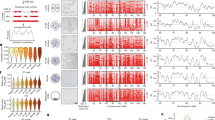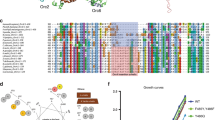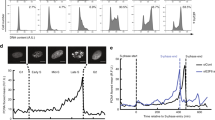Key Points
-
The genome is organized into distinct 1–2 Mb bands that contain numerous origins, which are coordinated to replicate in a programmed manner during S phase. These bands represent subunits of chromosome structure and function.
-
There is a general correlation between replication timing and gene expression. Housekeeping genes replicate early in S phase, whereas many tissue-specific genes are developmentally regulated — they replicate late in most cell types and early in the tissue of expression.
-
Genes that are expressed monoallelically replicate asynchronously in S phase, with one allele copied earlier than the other. This mechanism functions as an epigenetic mark for distinguishing between the alleles, and it is used both for genomic imprinting and for setting up allelic exclusion in the immune system and at olfactory-receptor gene loci. Asynchronous replication timing at several regions on each autosome is coordinated, and this might be carried out by individual control centres in a way that is similar to X inactivation.
-
The genomic replication-timing pattern is set up during the G1 stage of the cell cycle through interactions between cis-acting sequences and trans-acting factors that bring about epigenetic changes that have an impact on the firing of nearby replication origins during S phase. This process is probably controlled by cell-cycle-regulated factors.
-
Late replication might function as a mechanism for maintaining gene repression through many cell generations by causing DNA to be repackaged with deacetylated histones after passage through the replication fork. By contrast, early-replicating DNA is assembled with acetylated histones. In this way, replication time might influence gene accessibility.
Abstract
The eukaryotic genome is divided into well-defined DNA regions that are programmed to replicate at different times during S phase. Active genes are generally associated with early replication, whereas inactive genes replicate late. This expression pattern might be facilitated by the differential restructuring of chromatin at the time of replication in early or late S phase.
This is a preview of subscription content, access via your institution
Access options
Subscribe to this journal
Receive 12 print issues and online access
$209.00 per year
only $17.42 per issue
Buy this article
- Purchase on SpringerLink
- Instant access to full article PDF
Prices may be subject to local taxes which are calculated during checkout




Similar content being viewed by others
References
Hand, R. Eucaryotic DNA: organization of the genome for replication. Cell 15, 317–325 (1978).
Holmquist, G. P. Role of replication time in the control of tissue specific gene expression. Am. J. Hum. Genet. 40, 151–173 (1987).
Gottesfeld, J. & Bloomer, L. S. Assembly of transcriptionally active 5S RNA gene chromatin in vitro. Cell 28, 781–791 (1982).
Brown, D. D. The role of stable complexes that repress and activate eucaryotic genes. Cell 37, 359–365 (1984).
Latt, S. A. Microfluorometric detection of deoxyribonucleic acid replication in human metaphase chromosomes. Proc. Natl Acad. Sci. USA 70, 3395–3399 (1973).
Drouin, R., Lemieux, N. & Richer, C. L. Analysis of DNA replication during S phase by means of dynamic chromosome banding at high resolution. Chromosoma 99, 272–280 (1990).
Yunis, J. J. Mid-prophase human chromosomes. The attainment of 2000 bands. Hum. Genet. 56, 293–298 (1981).
Bernardi, G. Isochores and the evolutionary genomics of vertebrates. Gene 241, 3–17 (2000).
Tenzen, T. et al. Precise switching of DNA replication timing in the GC content transition area in the human major histocompatibility complex. Mol. Cell. Biol. 17, 4043–4050 (1997).
Watanabe, Y. et al. Chromosome-wide assessment of replication timing for human chromosomes 11q and 21q: disease-related genes in timing-switch regions. Hum. Mol. Genet. 11, 13–21 (2002).
Huberman, J. A. & Riggs, A. D. On the mechanism of DNA replication in mammalian chromosomes. J. Mol. Biol. 32, 327–341 (1968).
Hand, R. Regulation of DNA replication on subchromosomal units of mammalian cells. J. Cell Biol. 64, 89–97 (1975).
Raghuraman, M. K. et al. Replication dynamics of the yeast genome. Science 294, 115–121 (2001). The first report of a genome-wide replication timing map for a eukaryotic organism, the yeast Saccharomyces cerevisiae , which shows that there is no general correlation between gene expression and replication timing.
Goldman, M. A., Holmquist, G. P., Caston, L. A. & Nag, A. Replication timing of genes and middle repetitive sequences. Science 224, 686–692 (1984).
Schmidt, M. & Migeon, B. R. Asynchronous replication of homologous loci on human active and inactive X chromosome. Proc. Natl Acad. Sci. USA 87, 3685–3689 (1990).
Braunstein, D., Schulze, D., DelGiudice, T., Furst, A. & Schildkraut, C. L. The temporal order of replication of murine immunoglobulin heavy chain constant region sequences corresponds to their linear order in the genome. Nucleic Acids Res. 10, 6887–6902 (1982).
Gilbert, D. M. Temporal order of replication of Xenopus laevis 5S ribosomal RNA genes in somatic cells. Proc. Natl Acad. Sci. USA 83, 2924–2928 (1986).
Hansen, R. S., Canfield, T. K., Lamb, M. M., Gartler, S. M. & Laird, C. D. Association of fragile X syndrome with delayed replication of the FMR1 gene. Cell 73, 1403–1409 (1993).
Schubeler, D. et al. Genome-wide DNA replication profile for Drosophila melanogaster: a link between transcription and replication timing. Nature Genet. 32, 438–442 (2002). Genome-wide mapping that shows a strong correlation between replication timing and gene expression in Drosophila melanogaster.
Selig, S., Okumura, K., Ward, D. C. & Cedar, H. Delineation of DNA replication time zones by fluorescence in situ hybridization. EMBO J. 11, 1217–1225 (1992).
Gilbert, D. M. Replication timing and metazoan evolution. Nature Genet. 32, 336–337 (2002).
Reynolds, A. E., McCarroll, R. M., Newlon, C. S. & Fangman, W. L. Time of replication of ARS elements along yeast chromosome III. Mol. Cell. Biol. 9, 4488–4494 (1989).
Simon, I. et al. Developmental regulation of DNA replication timing at the human β globin locus. EMBO J. 20, 6150–6157 (2001).
Kerem, B. S., Goitein, R., Diamond, G., Cedar, H. & Marcus, M. Mapping of DNase-I sensitive regions on mitotic chromsomes. Cell 38, 493–499 (1984).
Reik, W. & Walter, J. Genomic imprinting: parental influence on the genome. Nature Rev. Genet. 2, 21–32 (2001).
Ferguson-Smith, A. C. & Surani, M. A. Imprinting and the epigenetic asymmetry between parental genomes. Science 293, 1086–1089 (2001).
Rand, E. & Cedar, H. Regulation of imprinting: a multi-tiered process. J. Cell. Biol. (in the press).
Kitsberg, D., Selig, S., Keshet, I. & Cedar, H. Replication structure of the human β-globin gene domain. Nature 366, 588–590 (1993).
Knoll, J. H. M., Cheng, S. -D. & Lalande, M. Allele specificity of DNA replication timing in the Angelman/Prader–Willi syndrome imprinted chromosomal region. Nature Genet. 6, 41–46 (1994).
Simon, I. et al. Asynchronous replication of imprinted genes is established in the gametes and maintained during development. Nature 401, 929–932 (1999). Shows evidence that asynchronous replication timing in mammalian cells has the characteristics of a primary imprinting mark.
Shemer, R. et al. The imprinting of the Prader–Willi/Angelman syndrome domain. Nature Genet. 26, 440–443 (2000).
Gunaratne, P. H., Nakao, M., Ledbetter, D. H., Sutcliffe, J. S. & Chinault, A. C. Tissue-specific and allele-specific replication timing control in the imprinted human Prader–Willi syndrome region. Genes Dev. 9, 808–820 (1995).
Avner, P. & Heard, E. X-chromosome inactivation: counting, choice and initiation. Nature Rev. Genet. 2, 59–67 (2001).
Lock, L. F., Takagi, N. & Martin, G. R. Methylation of the HPRT gene on the inactive X occurs after chromosome inactivation. Cell 48, 39–46 (1987).
Chess, A., Simon, I., Cedar, H. & Axel, R. Allelic inactivation regulates olfactory receptor gene expression. Cell 78, 823–834 (1994).
Bix, M. & Locksley, R. M. Independent and epigenetic regulation of the interleukin-4 alleles in CD4+ T Cells. Science 281, 1352–1354 (1998).
Mostoslavsky, R. et al. Asynchronous replication and allelic exclusion in the immune system. Nature 414, 221–225 (2001).
Rajewsky, K. Clonal selection and learning in the antibody system. Nature 381, 751–758 (1996).
Goldmit, M., Schlissel, M., Cedar, H. & Bergman, Y. Differential accessibility at the κ chain locus plays a role in allelic exclusion. EMBO J. 21, 5255–5261 (2002).
Mostoslavsky, R. et al. κ chain monoallelic demethylation and the establishment of allelic exclusion. Genes Dev. 12, 1801–1811 (1998).
Mombaerts, P. How smell develops. Nature Neurosci. 4, 1192–1198 (2001).
Nathans, J. et al. Molecular genetics of human blue cone monochromacy. Science 245, 831–838 (1989).
Ermakova, O. V. et al. Evidence that a single replication fork proceeds from early to late replicating domains in the IgH locus in a non-B cell line. Mol. Cell 3, 321–330 (1999).
Raghuraman, M. K., Brewer, B. J. & Fangman, W. L. Cell cycle-dependent establishment of a late replication program. Science 276, 806–809 (1997). Shows that the replication timing profile is established by cis -acting elements during early G1 phase.
Ferguson, B. M. & Fangman, W. L. A position effect on the time of replication origin activation in yeast. Cell 68, 333–339 (1992). The first evidence that cis -acting sequences have a function in dictating the time of origin firing.
Ofir, R., Wong, A. C., McDermid, H. E., Skorecki, K. L. & Selig, S. Position effect of human telomeric repeats on replication timing. Proc. Natl Acad. Sci. USA 96, 11434–11439 (1999).
Cosgrove, A. J. et al. Ku complex controls the replication time of DNA in telomere regions. Genes Dev. 16, 2485–2490 (2002).
Stevenson, J. B. & Gottschling, D. E. Telomeric chromatin modulates replication timing near chromosome ends. Genes Dev. 13, 146–151 (1999).
Friedman, K. L. et al. Multiple determinanats controlling activation of yeast replication origins late in S phase. Genes Dev. 10, 1595–1607 (1996).
Kitsberg, D. et al. Allele-specific replication timing of imprinted gene regions. Nature 364, 459–463 (1993).
Aladjem, M. I. et al. Participation of human β-globin locus control region in initation of DNA replication. Science 270, 815–819 (1995).
Aladjem, M. I., Rodewald, L. W., Kolman, J. L. & Wahl, G. M. Genetic dissection of a mammalian replicator in the human β-globin locus. Science 281, 1005–1009 (1998).
Aladjem, M. I. et al. Replication initiation patterns in the β-globin loci of totipotent and differentiated murine cells: evidence for multiple initiation regions. Mol. Cell. Biol. 22, 442–452 (2002).
Kamath, S. & Leffak, M. Multiple sites of replication initiation in the human β-globin gene locus. Nucleic Acids Res. 29, 809–817 (2001).
Forrester, W. C. et al. A deletion of the human β-globin locus activation region causes a major alteration in chromatin structure and replication across the entire β-globin locus. Genes Dev. 4, 1637–1649 (1990).
Cimbora, D. M. et al. Long-distance control of origin choice and replication timing in the human β-globin locus are independent of the locus control region. Mol. Cell. Biol. 20, 5581–5591 (2000).
Dimitrova, D. S. & Gilbert, D. M. The spatial position and replication timing of chromosomal domains are both established in early G1 phase. Mol. Cell 4, 983–993 (1999). The incubation in Xenopus egg extracts of mammalian nuclei isolated at different phases of the cell cycle showed that the organization of replication timing is established in early G1.
Gilbert, D. M. Nuclear position leaves its mark on replication timing. J. Cell Biol. 152, F11–F15 (2001).
Li, F. et al. The replication timing program of the Chinese hamster β-globin locus is established coincident with its repositioning near peripheral heterochromatin in early G1 phase. J. Cell Biol. 154, 283–292 (2001).
Bridger, J. M., Boyle, S., Kill, I. R. & Bickmore, W. A. Re-modelling of nuclear architecture in quiescent and senescent human fibroblasts. Curr. Biol. 10, 149–152 (2000).
Heun, P., Laroche, T., Raghuraman, M. K. & Gasser, S. M. The positioning and dynamics of origins of replication in the budding yeast nucleus. J. Cell Biol. 152, 385–400 (2001).
Vogelauer, M., Rubbi, L., Lucas, I., Brewere, B. J. & Grunstein, M. Histone acetylation regulates the time of replication origin firing. Mol. Cell 10, 1223–1233 (2002). Shows that in yeast the histone acetylation status in the vicinity of origins can determine its replication time.
Kagotani, K. et al. Replication timing properties within the mouse distal chromosome 7 imprinting cluster. Biosci. Biotechnol. Biochem. 66, 1046–1051 (2002).
Hansen, R. S. et al. Escape from gene silencing in ICF syndrome: evidence for advanced replication time as a major determinant. Hum. Mol. Genet. 9, 2575–2587 (2000).
Jablonka, E., Goitein, R., Marcus, M. & Cedar, H. DNA hypomethylation causes an increase in DNase-I sensitivity and an advance in the time of replication of the entire inactive X chromosome. Chromosoma 93, 152–156 (1985).
Donaldson, A. D. et al. CLB5-dependent activation of late replication origins in S. cerevisiae. Mol. Cell 2, 173–182 (1998).
Shirahige, K. et al. Regulation of DNA-replication origins during cell-cycle progression. Nature 395, 618–621 (1998).
Santocanale, C. & Diffley, J. F. A Mec1- and Rad53-dependent checkpoint controls late-firing origins of DNA replication. Nature 395, 615–618 (1998).
Paulovich, A. G. & Hartwell, L. H. A checkpoint regulates the rate of progression through S phase in S. cerevisiae in response to DNA damage. Cell 82, 841–847 (1995).
Gilbert, D. M. Replication timing and transcriptional control: beyond cause and effect. Curr. Opin. Cell Biol. 14, 377–383 (2002).
Zhang, J., Feng, X., Hashimshony, T., Keshet, I. & Cedar, H. The establishment of transcriptional competence in early and late S-phase. Nature 420, 198–202 (2002). Nuclear injection experiments showing that replicating DNA is automatically packaged in a repressed form during late S phase.
Jeppesen, P. & Turner, B. M. The inactive X chromosome in female mammals is distinguished by a lack of histone H4 acetylation, a cytogenetic marker for gene expression. Cell 74, 281–289 (1993).
Rountree, M. R., Bachman, K. E. & Baylin, S. B. DNMT1 binds HDAC2 and a new co-repressor, DMAP1, to form a complex at replication foci. Nature Genet. 25, 269–277 (2000). This work shows that histone deacetylase HDAC2 localizes to replication foci exclusively during late S phase in mammalian cells. This could function as a mechanism for repressing late-replicating genes.
Grunstein, M. Histone acetylation in chromatin structure and transcription. Nature 389, 349–352 (1997).
Sobel, R. E., Cook, R. G., Perry, C. A., Annunziato, A. T. & Allis, C. D. Conservation of deposition-related acetylation sites in newly synthesized histones H3 and H4. Proc. Natl Acad. Sci. USA 92, 1237–1247 (1995).
Razin, A. CpG methylation, chromatin structure and gene silencing — a three-way connection. EMBO J. 17, 4905–4908 (1998).
Surani, M. A., Barton, S. C. & Norris, M. L. Development of mouse eggs suggests imprinting of the genome during gametogenesis. Nature 308, 548–550 (1984).
McGrath, J. & Solter, D. Complementation of mouse embryogenesis requires both maternal and paternal genomes. Cell 37, 179–183 (1984).
Schumacher, A. Mechanisms and brain specific consequences of genomic imprinting in Prader–Willi and Angelman syndrome. Gene Funct. Dis. 1, 1–19 (2001).
Singh, N. et al. Coordination of the random asynchronous replication of autosomal loci. Nature Genet. (in the press).
Acknowledgements
This work was supported by grants from the National Institutes of Health, the Israel Cancer Research Fund and the Israel Science Foundation.
Author information
Authors and Affiliations
Corresponding author
Related links
Related links
DATABASES
LocusLink
OMIM
Saccharomyces Genome Database
Swiss-Prot
FURTHER INFORMATION
Glossary
- G BANDS
-
A characteristic chromosome-banding pattern that is shown by staining with Giemsa. Light and dark G bands differ in their molecular and regulatory features, such as gene density, repetitive sequence elements and replication timing.
- ISOCHORES
-
Long DNA fragments (>300 kb) defined by their average G+C content. Isochores are divided into five subfamilies according to their G+C composition: from G+C poor (∼40% G+C) to G+C rich (∼55–60% G+C).
- EPIGENETIC
-
Any heritable influence on the function of a chromosome or gene that is not caused by a change in DNA sequence.
- X-CHROMOSOME INACTIVATION
-
The transcriptional inactivation of one of the two X chromosomes in female embryos. The choice of the maternal or the paternal allele is random, but is then maintained clonally in subsequent cell generations. The inactive X chromosome is characterized by DNA methylation, late replication timing and condensed chromatin structure.
- X-INACTIVATION CENTRE
-
(Xic). A cis-acting region on the X chromosome that produces the X-inactivation-specific transcript (Xist) that is necessary for initiating X-chromosome inactivation in female cells.
- ALLELIC EXCLUSION
-
The process by which a cell (for example, from the immune or olfactory system) uses either the gene from its maternal chromosome or the one from the paternal chromosome, but not both.
- LOCUS CONTROL REGION
-
(LCR). A large regulatory sequence that harbours several elements that control gene expression and chromatin structure during development.
- CHECKPOINT
-
A point at which the cell-division cycle can be halted until conditions are suitable for the cell to proceed to the next stage.
- HETEROCHROMATIN
-
A cytologically defined genomic component that contains repetitive DNA (highly repetitive satellite DNA, transposable elements and ribosomal DNA gene clusters) and some protein-encoding genes.
- HISTONE ACETYLTRANSFERASE
-
(HAT). An enzyme that modifies histone tails covalently by adding an acetyl group to lysine residues, thereby changing their structure.
- CHROMATIN IMMUNOPRECIPITATION
-
(ChIP). A technique that isolates sequences from soluble DNA chromatin extracts (complexes of DNA and protein) by using antibodies that recognize specific chromosomal proteins.
- CPG ISLANDS
-
Sequences (0.5–2 kb) that are rich in the CpG dinucleotide, which are mostly located upstream to housekeeping and some tissue-specific genes. They are constitutively non-methylated in all animal cell types.
Rights and permissions
About this article
Cite this article
Goren, A., Cedar, H. Replicating by the clock. Nat Rev Mol Cell Biol 4, 25–32 (2003). https://doi.org/10.1038/nrm1008
Issue Date:
DOI: https://doi.org/10.1038/nrm1008
This article is cited by
-
DNA replication fork speed underlies cell fate changes and promotes reprogramming
Nature Genetics (2022)
-
Chromosomal coordination and differential structure of asynchronous replicating regions
Nature Communications (2021)
-
Programming asynchronous replication in stem cells
Nature Structural & Molecular Biology (2017)
-
Strategic role of the ubiquitin-dependent segregase p97 (VCP or Cdc48) in DNA replication
Chromosoma (2017)
-
Expansive marker analysis replicating the association of glaucoma susceptibility with human chromosome loci 1q43 and 10p12.31
European Journal of Human Genetics (2014)



